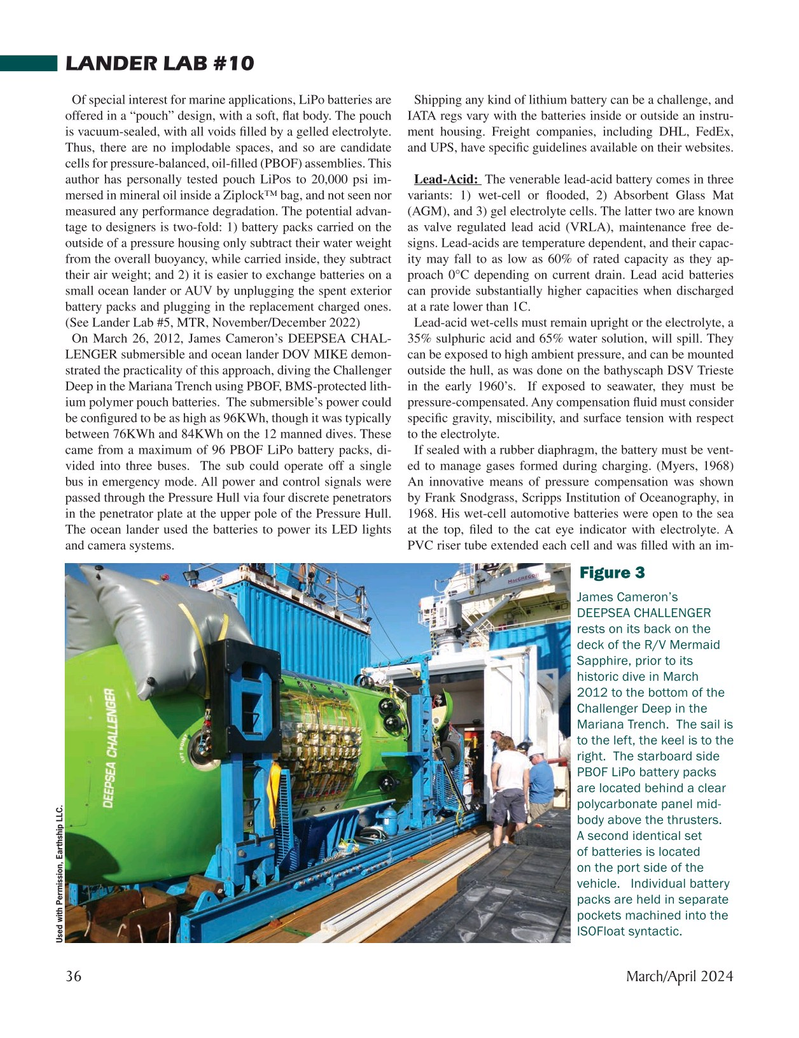
Page 36: of Marine Technology Magazine (March 2024)
Read this page in Pdf, Flash or Html5 edition of March 2024 Marine Technology Magazine
LANDER LAB #10
Of special interest for marine applications, LiPo batteries are Shipping any kind of lithium battery can be a challenge, and offered in a “pouch” design, with a soft, ? at body. The pouch IATA regs vary with the batteries inside or outside an instru- is vacuum-sealed, with all voids ? lled by a gelled electrolyte. ment housing. Freight companies, including DHL, FedEx,
Thus, there are no implodable spaces, and so are candidate and UPS, have speci? c guidelines available on their websites.
cells for pressure-balanced, oil-? lled (PBOF) assemblies. This author has personally tested pouch LiPos to 20,000 psi im- Lead-Acid: The venerable lead-acid battery comes in three mersed in mineral oil inside a Ziplock™ bag, and not seen nor variants: 1) wet-cell or ? ooded, 2) Absorbent Glass Mat measured any performance degradation. The potential advan- (AGM), and 3) gel electrolyte cells. The latter two are known tage to designers is two-fold: 1) battery packs carried on the as valve regulated lead acid (VRLA), maintenance free de- outside of a pressure housing only subtract their water weight signs. Lead-acids are temperature dependent, and their capac- from the overall buoyancy, while carried inside, they subtract ity may fall to as low as 60% of rated capacity as they ap- their air weight; and 2) it is easier to exchange batteries on a proach 0°C depending on current drain. Lead acid batteries small ocean lander or AUV by unplugging the spent exterior can provide substantially higher capacities when discharged battery packs and plugging in the replacement charged ones. at a rate lower than 1C.
(See Lander Lab #5, MTR, November/December 2022) Lead-acid wet-cells must remain upright or the electrolyte, a
On March 26, 2012, James Cameron’s DEEPSEA CHAL- 35% sulphuric acid and 65% water solution, will spill. They
LENGER submersible and ocean lander DOV MIKE demon- can be exposed to high ambient pressure, and can be mounted strated the practicality of this approach, diving the Challenger outside the hull, as was done on the bathyscaph DSV Trieste
Deep in the Mariana Trench using PBOF, BMS-protected lith- in the early 1960’s. If exposed to seawater, they must be ium polymer pouch batteries. The submersible’s power could pressure-compensated. Any compensation ? uid must consider be con? gured to be as high as 96KWh, though it was typically speci? c gravity, miscibility, and surface tension with respect between 76KWh and 84KWh on the 12 manned dives. These to the electrolyte.
came from a maximum of 96 PBOF LiPo battery packs, di- If sealed with a rubber diaphragm, the battery must be vent- vided into three buses. The sub could operate off a single ed to manage gases formed during charging. (Myers, 1968) bus in emergency mode. All power and control signals were An innovative means of pressure compensation was shown passed through the Pressure Hull via four discrete penetrators by Frank Snodgrass, Scripps Institution of Oceanography, in in the penetrator plate at the upper pole of the Pressure Hull. 1968. His wet-cell automotive batteries were open to the sea
The ocean lander used the batteries to power its LED lights at the top, ? led to the cat eye indicator with electrolyte. A and camera systems. PVC riser tube extended each cell and was ? lled with an im-
Figure 3
James Cameron’s
DEEPSEA CHALLENGER rests on its back on the deck of the R/V Mermaid
Sapphire, prior to its historic dive in March 2012 to the bottom of the
Challenger Deep in the
Mariana Trench. The sail is to the left, the keel is to the right. The starboard side
PBOF LiPo battery packs are located behind a clear polycarbonate panel mid- body above the thrusters.
A second identical set of batteries is located on the port side of the vehicle. Individual battery packs are held in separate pockets machined into the
ISOFloat syntactic.
Used with Permission, Earthship LLC.
36 March/April 2024
MTR #3 (34-47).indd 36 4/4/2024 10:51:34 AM

 35
35

 37
37
